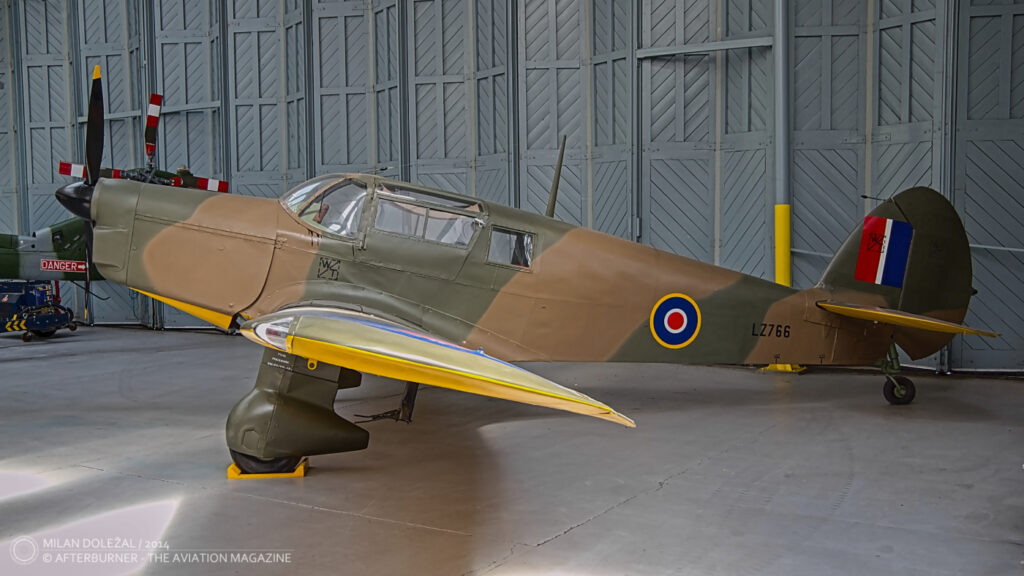 Percival Proctor Mk III (c/n H.536, formerly LZ766 of the Royal Air Force and then G-ALCK), on display with Imperial War Museum Duxford, June 2014.
Percival Proctor Mk III (c/n H.536, formerly LZ766 of the Royal Air Force and then G-ALCK), on display with Imperial War Museum Duxford, June 2014.
In November of 1935, Vega Gull four-seat touring aircraft performed its maiden flight. The aeroplane was developed by Percival Aircraft Ltd. and represented another addition to the so-called ´D-series´ of Gull aeroplanes made by the company and successfully introduced into the market in the early 1930s.
All four aeroplanes – Gull, Gull Four, Gull Six and Gull Vega – were popular touring and sport aircraft, used mainly in the Great Britain and the Commonwealth countries. Several aviation milestones and record-breaking flights were achieved with the Gull aircraft family, including the first non-stop solo crossing of the Atlantic Ocean by a woman (being also the first east-to-west solo crossing), made in 1936 by Beryl Markham in the Vega Gull. A few aircraft from the Gull series were acquired by air forces and operated as liaison, courier and training aeroplanes.
In 1938, the Air Ministry issued Specification 20/38 for a radio trainer and communications aircraft, choosing the Vega Gull as winner of that contract. Certainly, not without significance was the fact that aeroplanes from the Gull family were previously evaluated by the RAF and received good reviews.
However, to adopt the aircraft for radio training duties, several changes were made to the initial design. First of all, additional space was needed for radio and communications equipment, and that was achieved by removing one seat and extending the aircraft fuselage. The aeroplane also received larger cabin windows and new seats that allowed the crew to wear parachutes. The modified aircraft was designated Percival Proctor Mk I (company designation P.28) and completed its first flight in October of 1939.
The Proctor Mk I was low-wing monoplane with fixed tailwheel undercarriage and airframe made of wood and fabric. The aeroplane was powered by de Havilland Gipsy Queen II engine, generating 210 hp.
Initial orders for the Proctor Mk I aircraft included 147 aeroplanes for the RAF and another 100 for the Fleet Air Arm (designated Mk IA). However, the Percival company made only approximately 220 of them and then the manufacturing was subcontracted to F. Hills & Sons that continued with production of the Proctors until the end of the war. Further variants of the aeroplane, designated Mk II to Mk IV, were equipped with different variants of radio equipment. In 1941, the fourth seat was also added in the Proctor Mk IV.
Although the initial Gull family aircraft were known of its good flying characteristics, especially the speed, that could not be said about the Proctor. The weight of radio and communications suite, as well as other military equipment – such as dinghy boat and naval instruments with the Mk IA – proved to be quite a heavy load for the original Queen II engine and flight performance of the Proctor was rather poor. Especially with the latest variants that were redesigned to be even heavier and larger. One of the Proctor Mk IV aeroplanes was even equipped with more powerful engine, the 250 hp Gipsy Queen 31, but never went beyond the prototype stage.
An interesting fact is that the Proctor prototype was also tested for the role of bomber aircraft. It occurred in 1940, in the face of danger of German invasion to Britain. When it was clear the invasion plans failed, the idea of the light-bomber Proctor was quickly abandoned.
When the war was over, the RAF and FAA quickly disposed most of their Proctors. Majority of them were sold on civil market but some were also acquired by newly re-established European air forces that desperately needed training and liaison aircraft. In this way, the Proctors were acquired by Australia, Belgium, Denmark, France and the Netherlands.
After the war, the Percival company developed another variant of the aeroplane. It was designated Mk V (company designation P.44) and tailored for the civil market. A total number of 154 Proctor Mk V was built and sold worldwide. In 1948, the aeroplane was marketed as ´the most popular British light aircraft in the world´.
The Proctor fleet was operational until the early 1960s when the first concerns related to its airworthiness appeared. They were related with worldwide issue of structural problems with glued, wooden airframes of aeroplanes manufactured during the war in the early post-war years. Eventually, the entire Proctor fleet was grounded, together with a few other aircraft. It quickly led to almost complete extinction of the affected types.
The aeroplane LZ766, featured within our Photo of the Week series, was built in 1944 as the Proctor Mk III (company designation P.34). Then, the aircraft was used by the RAF for Bomber Command training duties. In 1948, the LZ766 was sold to civilian operator and registered as G-ALCK.
In 1963, the aeroplane was grounded due to aforementioned issues with airframe structure. Shortly after, it was written off the register and then acquired by Imperial War Museum for display purposes.



